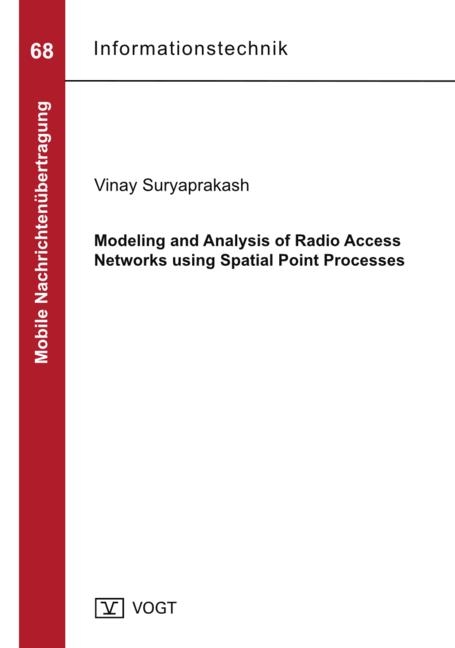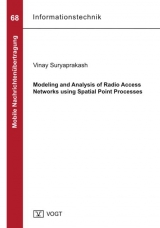Modeling and Analysis of Radio Access Networks using Spatial Point Processes
Seiten
- Keine Verlagsinformationen verfügbar
- Artikel merken
The popularity of smart phones and the rapid expansion of mobile data services have made catering to user demands, of high data rates and ubiquitous coverage, more daunting than ever before. Efforts to meet these challenges have resulted in the deployment of increasingly dense and heterogeneous networks. This thesis provides models using spatial point processes to help understand, analyze, and optimize these networks.
This thesis begins by providing simple extensions, in the form of increased correlation between users and base stations, to existing work on homogeneous networks using stationary Poisson processes. These efforts result in expressions for the interference, the probability of coverage, and spectral efficiency (or spatially averaged rate). The expressions are utilized to calculate the energy consumed by the network as well as compare two commonly used energy management strategies, namely, sleep modes and bandwidth variation. These investigations reveal that the amount of energy consumed is highly dependent on the network load, and that sleep modes are more effective in saving energy than bandwidth variation. Then, staying with homogeneous networks, this thesis furnishes a model that helps compute the deployment cost of a network with k network components, while ensuring that users’ demands are met. As a special case, a three layer network consisting of users, base stations, and backhaul nodes is considered. The expression for deployment cost in this case is found, and it is followed by a numerical evaluation, which shows that there exists a backhaul intensity which can minimize the deployment cost while guaranteeing users’ demands.
The focus of this thesis is subsequently shifted to heterogeneous networks, where it provides an alternative to the most popular method of modeling heterogeneous networks, viz. the superposition of independent, stationary Poisson processes. The model proposed here uses a stationary Poisson cluster process in which micro base stations are clustered around macro base stations. An expression which provides the complete description of the interference in such a network is found. The utility of this find is demonstrated by finding expressions for the probability of coverage and spectral efficiency. Though the expressions found are easy to evaluate numerically, they are rather cumbersome. Therefore, in an effort to describe them more succinctly, the asymptotic behavior of the interference is examined using an estimator. This results in a theorem which states that the distribution of the interference is asymptotically Gaussian. Following which, the expressions for the mean and the variance of the interference are obtained. The asymptotic convergence of the interference as well as the expressions for its mean and variance are verified by using Monte-Carlo simulations. These simulations corroborate the accuracy of these findings and also reveal that, in most optimization problems that deal with dense networks, the sole use of the mean of the interference should suffice.
After which, the focus of this thesis is briefly shifted back to homogeneous networks, where a stationary Neyman-Scott process is used to model a network in which users are clustered around base stations. As in the previous cases, an expression for a complete description of the interference, along with expressions for the probability of coverage and spectral efficiency, is derived. These expressions are also numerically evaluated. Once again, in an effort to make these expressions more tractable, the asymptotic behavior of the interference is examined. Interestingly, this results in a theorem which also states that the distribution of the interference is asymptotically Gaussian. Thereby, making the expressions, which were previously found, more convenient to use.
Lastly, this thesis establishes a model to analyze the deployment cost of a network consisting of two backhaul technologies (namely, microwave and fiber optic backhaul), two types of base stations (i.e., macro and micro base stations), and users. An expression for the average cost of deploying a backhaul node in a network, which can cater to users’ demands effectively, is found. This is later used to find the total deployment cost of the network. Numerical evaluations of these expressions show that, as in the previous cost model, there exist a range of backhaul intensities that can minimize the deployment cost of a network while satisfying the given constraints.
This thesis begins by providing simple extensions, in the form of increased correlation between users and base stations, to existing work on homogeneous networks using stationary Poisson processes. These efforts result in expressions for the interference, the probability of coverage, and spectral efficiency (or spatially averaged rate). The expressions are utilized to calculate the energy consumed by the network as well as compare two commonly used energy management strategies, namely, sleep modes and bandwidth variation. These investigations reveal that the amount of energy consumed is highly dependent on the network load, and that sleep modes are more effective in saving energy than bandwidth variation. Then, staying with homogeneous networks, this thesis furnishes a model that helps compute the deployment cost of a network with k network components, while ensuring that users’ demands are met. As a special case, a three layer network consisting of users, base stations, and backhaul nodes is considered. The expression for deployment cost in this case is found, and it is followed by a numerical evaluation, which shows that there exists a backhaul intensity which can minimize the deployment cost while guaranteeing users’ demands.
The focus of this thesis is subsequently shifted to heterogeneous networks, where it provides an alternative to the most popular method of modeling heterogeneous networks, viz. the superposition of independent, stationary Poisson processes. The model proposed here uses a stationary Poisson cluster process in which micro base stations are clustered around macro base stations. An expression which provides the complete description of the interference in such a network is found. The utility of this find is demonstrated by finding expressions for the probability of coverage and spectral efficiency. Though the expressions found are easy to evaluate numerically, they are rather cumbersome. Therefore, in an effort to describe them more succinctly, the asymptotic behavior of the interference is examined using an estimator. This results in a theorem which states that the distribution of the interference is asymptotically Gaussian. Following which, the expressions for the mean and the variance of the interference are obtained. The asymptotic convergence of the interference as well as the expressions for its mean and variance are verified by using Monte-Carlo simulations. These simulations corroborate the accuracy of these findings and also reveal that, in most optimization problems that deal with dense networks, the sole use of the mean of the interference should suffice.
After which, the focus of this thesis is briefly shifted back to homogeneous networks, where a stationary Neyman-Scott process is used to model a network in which users are clustered around base stations. As in the previous cases, an expression for a complete description of the interference, along with expressions for the probability of coverage and spectral efficiency, is derived. These expressions are also numerically evaluated. Once again, in an effort to make these expressions more tractable, the asymptotic behavior of the interference is examined. Interestingly, this results in a theorem which also states that the distribution of the interference is asymptotically Gaussian. Thereby, making the expressions, which were previously found, more convenient to use.
Lastly, this thesis establishes a model to analyze the deployment cost of a network consisting of two backhaul technologies (namely, microwave and fiber optic backhaul), two types of base stations (i.e., macro and micro base stations), and users. An expression for the average cost of deploying a backhaul node in a network, which can cater to users’ demands effectively, is found. This is later used to find the total deployment cost of the network. Numerical evaluations of these expressions show that, as in the previous cost model, there exist a range of backhaul intensities that can minimize the deployment cost of a network while satisfying the given constraints.
| Erscheint lt. Verlag | 17.11.2014 |
|---|---|
| Sprache | englisch |
| Maße | 148 x 210 mm |
| Gewicht | 200 g |
| Themenwelt | Technik ► Elektrotechnik / Energietechnik |
| Schlagworte | Mobilfunk • Modeling and Analysis, Radio Access Networks, Spatial Point Processes • RAN |
| ISBN-10 | 3-938860-79-0 / 3938860790 |
| ISBN-13 | 978-3-938860-79-3 / 9783938860793 |
| Zustand | Neuware |
| Haben Sie eine Frage zum Produkt? |
Mehr entdecken
aus dem Bereich
aus dem Bereich
Kolbenmaschinen - Strömungsmaschinen - Kraftwerke
Buch | Hardcover (2023)
Hanser (Verlag)
49,99 €




